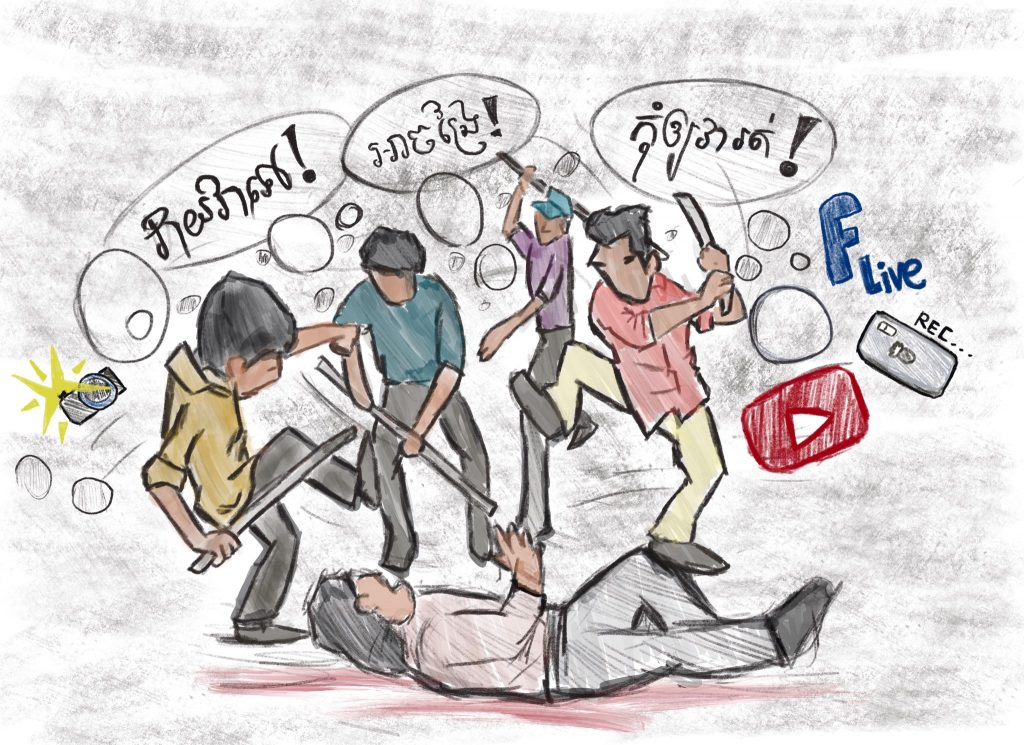ការលើកឡើងពីបញ្ហា “ការកាត់ទោសដោយមហាជន” នៅប្រទេសកម្ពុជា
នៅចន្លោះឆ្នាំ ២០១០ និង ២០១៨ មានមនុស្សចំនួន ៧៣នាក់បានក្លាយជាជនរងគ្រោះនៃអំពើហឹង្សាក្រៅប្រព័ន្ធតុលាការ ដែលជាទូទៅត្រូវបានគេហៅថា “តុលាការមហាជន” រឺ “ការសម្លាប់ដោយហ្វូងមនុស្ស” ហើយអំពើហឹង្សាទាំងនេះបានបណ្តាលអោយមានមនុស្ស ៥៧នាក់ស្លាប់និង ១៦នាក់របួស។1 តួលេខទាំងនោះត្រូវបានអ្នកជំនាញចាត់ទុកថា វានៅទាបជាងច្រើនពីការប៉ាន់ប្រមាណទុក ដោយសារតែអាជ្ញាធរមិនបានធ្វើការកត់ត្រាទុកនូវចំនួនមនុស្សបានទាំងអស់។2
អង្គការសហប្រជាជាតិកំណត់និយមន័យ “ការសម្លាប់តាមទំនើងចិត្ត” ជាការដកហូតជីវិតតាមអំពើចិត្តដែលជាលទ្ធផលនៃការសម្លាប់មនុស្សដោយអនុវត្តទៅតាមបទបញ្ជារបស់ស្ថាប័នរដ្ឋាភិបាលជាមួយនឹងភាពស្មុគស្មាញ ឬការអត់ឱន ឬលើកលែងទោសដោយគ្មាននីតិវិធីតុលាការ ឬច្បាប់ណាមួយឡើយ ហើយ “ការប្រហារជីវិតក្រៅប្រព័ន្ធតុលាការ” គឺជាការសម្លាប់ដែលបានប្រព្រឹត្តនៅក្រៅនីតិវិធីតុលាការ ឬក្រៅដំណើរការច្បាប់ ទន្ទឹមនឹងនេះ វាល្មើសទាំងច្បាប់ជាតិ និងច្បាប់អន្តរជាតិដែលពាក់ព័ន្ធនានា។3 យោងតាមលិខិតុបរណ៍ច្បាប់ជាធរមាន និយមន័យនេះក៏រួមបញ្ចូលការសម្លាប់ដោយហ្វូងមនុស្សទៅក្នុងចំណោមគុណវុឌ្ឍិជាច្រើនទៀតដែរ។4 តាមរយៈទ្រឹស្តីដែលមនុស្សភាគច្រើនបានដឹងមកហើយនោះ រដ្ឋតែមួយគត់ដែលមានសិទ្ធិផ្តាច់មុខលើការប្រើប្រាស់អំពើហឹង្សាដោយស្របច្បាប់ ព្រោះថាបុគ្គលម្នាក់ៗបានសំរេចប្រគល់សិទ្ធិប្រើអំពើហឹង្សាដល់រដ្ឋ ហើយពួកគេពឹងផ្អែកលើស្ថាប័នរដ្ឋដើម្បីប្រើប្រាស់វានៅពេលចាំបាច់។ ចំពោះនិទណ្ឌភាពនៃគោលការណ៍នេះ រដ្ឋក៏ចាំបាច់ក្នុងការធ្វើអន្តរាគមន៍ផងដែរនៅពេលដែលពលរដ្ឋប្រើអំពើហឹង្សាប្រឆាំងនឹងគ្នា។5នៅក្នុងប្រទេសមួយដែលគ្រប់គ្រងដោយនីតិរដ្ឋ ដូចប្រទេសកម្ពុជាដែលបានប្រកាសដោយបុព្វកថារដ្ឋធម្មនុញ្ញកម្ពុជាឆ្នាំ១៩៩៣6 ដើម្បីប្រើប្រាស់អំពើហិង្សាដោយស្របច្បាប់បាន កម្ពុជាត្រូវតែគោរពតាមក្របខ័ណ្ឌនៃច្បាប់ដែលត្រូវអនុវត្តដោយប្រទេសនិងពលរដ្ឋកម្ពុជាទាំងអស់ ព្រមទាំងគោរពតាមសេចក្តីវិនិច្ឆ័យនៃអំណាចតុលាការផងដែរ។7

ឈុតឆាកនៃអំពើហិង្សាដោយហ្វូងមនុស្ស។ គំនូរត្លុកដោយក្រុមការងារអូឌីស៊ី គូរនៅថ្ងៃទី ១៦ ខែតុលាឆ្នាំ ២០១៩ ។ ក្រោមអាជ្ញាប័ណ្ណ CC BY 2.0.
“អំពើហឹង្សាក្រៅប្រព័ន្ធតុលាការ” គឺជាពាក្យដែលគេប្រើចំពោះសកម្មភាពហឹង្សានានានៃ “ការកាត់ទោសដោយមហាជន” (តុលាការមហាជន) ដែលវាត្រូវបានគេពណ៌នាថា ជាការឆ្លើយតបពីសំណាក់ពលរដ្ឋ និងអ្នកដំណើរឆ្លងកាត់ ដែលជារឿយៗ វាជាប្រតិកម្មឬការសងសឹកភ្លាមៗនៅពេលមានព្រឹត្តិការណ៍មួយកើតឡើងពាក់ព័ន្ធទៅនឹងបទល្មើសជាក់ស្តែងឬគិតទុកជាមុន។8 ភាគច្រើននៃករណីទាំងនេះត្រូវបានជួបប្រទះច្រើនលើករណីគ្រោះថ្នាក់ចរាចរណ៍នៅពេលដែលជនបង្កគ្រោះថ្នាក់ព្យាយាមរត់គេចចេញពីកន្លែងកើតហេតុ (“បុកហើយបើករត់”) ករណីលួចឆក់ ឬសូម្បីតែការចោទប្រកាន់ដែលពាក់ព័ន្ធនឹងអំពើអាបធ្មប់។9 អស់រយៈពេលជាច្រើនទស្សវត្សមកនេះ ដោយគិតចាប់តាំងពីឆ្នាំ២០០២10 មកទាល់បច្ចុប្បន្ននេះ សកម្មភាពអំពើហឹង្សាទាំងនេះនៅតែបន្តកើតឡើងជាដដែលៗ ហាក់ដូចជាមិនអាចឈានទៅរកទីបញ្ចប់បានទាល់តែសោះ បើទោះបីជាមានការអំពាវនាវម្តងហើយម្តងទៀតពីសំណាក់តំណាងសហគមន៍អន្តរជាតិយ៉ាងណាក៏ដោយ។11
បាតុភូតនេះបង្ហាញពីកម្សោយជាច្រើនដែលនៅតែបន្តជះឥទ្ធិពលដល់ប្រទេសកម្ពុជា និងប្រព័ន្ធតុលាការរបស់ខ្លួន។ មន្ត្រីយុត្តិធម៌ម្នាក់ បានមានប្រសាសន៍ថា អំពើហឹង្សានៅតាមដងផ្លូវនេះជារោគសញ្ញានៃ “ជំងឺសង្គមដ៏រ៉ាំរ៉ៃ” មួយ12 ដែលលោកចាត់ទុកថាជាការប្រឆាំងយ៉ាងខ្លាំងពីសំណាក់ពលរដ្ឋកម្ពុជាចំពោះស្ថាប័នយុត្តិធម៌របស់លោក។ ការណ៍នេះក៏បង្ហាញពីភាពគ្មានប្រសិទ្ធភាពនៃការងាររបស់មន្ត្រីប៉ូលីសក្នុងការបង្ការ និងចាប់ខ្លួនឧក្រិដ្ឋជន រួមទាំងអ្នកប្រព្រឹត្តបទល្មើសផ្សេងទៀត ដើម្បីផ្តល់យុត្តិធម៌ដោយការតាមចាប់ពួកគេ និងបញ្ជូនទៅកាន់ពន្ធនាគារដើម្បីទទួលទណ្ឌកម្មឱ្យបានសាកសមទៅនឹងអំពើរបស់ពួកគេ។13 លើសពីនេះទៅទៀត ប្រព័ន្ធតុលាការរបស់ប្រទេសកម្ពុជាត្រូវបានគេសន្មត់ថាមិនគួរឱ្យទុកចិត្ត ដោយជឿថា វាមិនឆ្លើយតបនឹងការរំពឹងទុករបស់សង្គមនោះទេ។ 14
ជាឧទាហរណ៍ មានករណីគ្រោះថ្នាក់ចរាចណ៍ជាច្រើនអាចលើកយកមកបង្ហាញពីស្ថានភាពនេះបាន។ ដូចជាករណីបុកហើយបើករត់ជាដើម អ្នកដែលត្រូវទទួលខុសត្រូវចំពោះគ្រោះថ្នាក់ចរាចរណ៍នេះសុខចិត្តជ្រើសរើសយកការបើករត់គេចពីហេតុការណ៍ ជាជាងឈប់រថយន្តដើម្បីចុះជួយជនរងគ្រោះ និងនៅតទល់ជាមួយនឹងកំហឹងមហាជន។ មានអ្នកខ្លះព្យាយាមរត់ទៅឆ្ងាយតាមតែអាចធ្វើបានដើម្បីទៅជ្រកនៅប៉ុស្តិ៍ប៉ូលីស ដែលជួយគេប្រឆាំងនឹងការកាត់ទោសដោយមហាជន។ លើសពីនេះទៅទៀត ចំពោះអ្នកមានទ្រព្យសម្បត្តិច្រើនក្នុងរឿងក្ដីករណីបុកហើយបើករត់ជាច្រើន ការកាត់ទោសរបស់ចៅក្រមច្រើនតែមានកម្រិតស្រាលហើយសំណងសម្រាប់ជនរងគ្រោះគឺអាចនឹងគ្មាន ឬអោយទាបបំផុត។15 ករណីទាំងនេះមិនបានជួយដោយក្រុមប៉ូលីសក្នុងការស៊ើបអង្កេតអ្វីក្រៅពីតម្រូវឱ្យមានថែមសេវាក្រៅ ដែលវាអាស្រ័យលើសមត្ថភាពនៃការចំនាយរបស់ជនរងគ្រោះ ហើយវាមិនមែនជាសេវាសាធារណៈដែលគួរតែផ្តល់ដោយមិនគិតកម្រៃ និងបើកចំហដល់ជនគ្រប់គ្នាដោយស្មើភាពនោះទេ។16
ជាលទ្ធផល ពីហឹង្សាតាមដងផ្លូវនៅប្រទេសកម្ពុជាទៅអនាគត អំពើហឹង្សាដោយហ្វូងមនុស្សហាក់នឹងក្លាយជាមធ្យោបាយតែមួយគត់ដែលត្រូវបានធ្វើឡើងដើម្បីធានាឱ្យបាននូវយុត្តិធម៌ឆាប់រហ័ស និងយុត្តិធម៌សម្រាប់ភាពធ្ងន់ធ្ងរនៃបទល្មើស។17 អស់រយៈពេលជាយូរមកហើយ អាជ្ញាធរនៅតែអសកម្មនៅចំពោះបាតុភូតបែបនេះ។18 នេះអាចត្រូវបានពន្យល់ដោយសារ កង្វះមធ្យោបាយ និងឆន្ទៈនយោបាយដើម្បីព្យាយាមគ្រប់គ្រងក្រុមមនុស្សមានដល់ទៅរាប់រយនាក់ ដែលកំពុងស្វែងរកគោលដៅត្រឹមត្រូវ។ លើសពីនេះក្នុងករណីខ្លះ មន្ត្រីប៉ូលីសអាចធ្វើជាសាក្សីនៅកន្លែងកើតហេតុ ប៉ុន្តែពួកគេជ្រើសរើសមិនធ្វើវាទៅវិញដោយសារតែភាពភ័យខ្លាចដែលអាចនឹងមានការវាយប្រហារពីសំណាក់ហ្វូងមនុស្សដែលកំពុងពោរពេញទៅដោយកំហឹង ឬអាចដោយសារតែកង្វះការបណ្តុះបណ្តាលនិងការយល់ដឹងអំពីក្រមសីលធម៌ មន្ត្រីប៉ូលីសជាច្រើនអាចនឹងចាត់ទុកថា អំពើហឹង្សាក្រៅប្រព័ន្ធតុលាការជាអំពើស្របច្បាប់។19
យ៉ាងណាមិញ វាពិតជាចាំបាច់ណាស់ក្នុងការបង្ហាញឡើងវិញថា អំពើហឹង្សាដោយហ្វូងមនុស្ស គឺជាបទល្មើសព្រហ្មទណ្ឌ។ ក្រមព្រហ្មទណ្ឌរួមបញ្ចូលបទល្មើសព្រហ្មទណ្ឌទាំងអស់ ដែលពាក់ព័ន្ធនឹងអំពើនៃ “ការកាត់ទោសដោយមហាជន” ដែលរួមមានមនុស្សឃាត ទារុណកម្ម និងអំពើឃោរឃៅ អំពើហឹង្សាដោយទារុណកម្ម និងការគំរាមកំហែង។20 ថ្វីបើរាល់ការប្រព្រឹត្តខុសដែលអាចនឹងត្រូវដាក់ការស្តីបន្ទោសដល់បុគ្គលនោះ ប៉ុន្តែនៅក្នុងប្រទេសមួយដែលគ្រប់គ្រងដោយនីតិរដ្ឋ មនុស្សម្នាក់ៗនៅតែបន្តទទួលបានការការពារដោយច្បាប់។ រដ្ឋធម្មនុញ្ញនៃព្រះរាជាណាចក្រកម្ពុជាជារួមមានជំពូកមួយស្តីពីសិទ្ធិ និងកាតព្វកិច្ចរបស់ប្រជាពលរដ្ឋខ្មែរ21 ដែលទទួលស្គាល់ និងគោរពសិទ្ធិមនុស្សដូចដែលបានចែងនៅក្នុងសេចក្តីប្រកាសជាសកលស្តីពីសិទ្ធិមនុស្ស22 និងសន្ធិសញ្ញាសិទ្ធិមនុស្សអន្តរជាតិទាំងអស់។23 បុគ្គលម្នាក់ៗត្រូវបានការពារដោយសិទ្ធិមូលដ្ឋានជាច្រើន ជាពិសេសដោយសមភាពនៅចំពោះមុខច្បាប់24 ដូចជា សិទ្ធិរស់រានមានជិវិត សិទ្ធិសេរីភាព សិទ្ធិទទួលបានសន្តិសុខ25 សិទ្ធិក្នុងការសន្មត់ជាមុនថាគ្មានទោស និងសិទ្ធិការពារក្តីតាមផ្លូវច្បាប់26 ការហាមប្រាណមិនឱ្យមានការរើសអើង27 និងការហាមប្រាណមិនឱ្យមានការរំលោភបំពានលើរាងកាយ។28
យោងតាមសន្ធិសញ្ញាសិទ្ធិមនុស្សអន្តរជាតិដែលមានព្រះរាជាណាចក្រកម្ពុជាជាភាគី រួមទាំងរដ្ឋធម្មនុញ្ញ និងក្រមព្រហ្មទណ្ឌ រាជរដ្ឋាភិបាលនៃកម្ពុជាមានកាតព្វកិច្ចដើម្បីបង្ការការកើតឡើងនៃការសម្លាប់ដោយហ្វូងមនុស្ស។ ជាការពិតណាស់ ចាប់តាំងពីដើមទសវត្សឆ្នាំ២០០០ ជាពេលនៃអំពើហឹង្សាក្រៅប្រព័ន្ធតុលាការបានឈានដល់កម្រិតគួរឱ្យព្រួយបារម្ភ ចំនួនករណីដែលបានរាយការណ៍បានថយចុះបន្តិចម្តងៗ ជាមួយនឹងស្ថេរភាពនយោបាយ និងការបើកទីផ្សារសេដ្ឋកិច្ចដែលធ្វើឱ្យមានលទ្ធភាពធានាបាននូវបរិយាកាសសន្តិភាពនៅកម្ពុជា។29 យ៉ាងណាមិញ ករណីនៃការសម្លាប់ខ្លះនៅតែជាប្រធានបទធំនៅក្នុងប្រព័ន្ធផ្សព្វផ្សាយ ដែលរូបភាព និងវីដេអូនៃអំពើសម្លាប់ដោយហ្វូងមនុស្សនេះ ត្រូវបានគេយកទៅប្រើប្រាស់ក្នុងសារព័ត៌មាន និងចែកចាយបន្តតាមបណ្តាញផ្សព្វផ្សាយសង្គមយ៉ាងទូលំទូលាយ។ ការអនុវត្តបែបនេះកំពុងតែជួយបង្កើនភាពស្របច្បាប់នៃទង្វើទាំងនោះនៅក្នុងក្រសែភ្នែកប្រជាជនកម្ពុជា ដោយធ្វើឱ្យការប្រើអំពើហឹង្សាក្លាយទៅជារឿងសាមញ្ញនិងធម្មតាដើម្បីឆ្លើយតបទៅនឹងឥរិយាបទប្រឆាំងនឹងសង្គម។30 លើសពីនេះ ការធ្វើឱ្យអំពើហឹង្សាកាន់តែមានប្រជាប្រិយភាព ទំនងនឹងក្លាយជាការបង្ហាញនូវអសន្តិសុខសង្គម31 ដែលបណ្តាលមកពីដោយការផ្លាស់ប្តូរខាងសេដ្ឋកិច្ច ភាពតានតឹងជាតិនិយម ដូចជាការកើនឡើងនូវសញ្ចេតនាប្រឆាំងវៀតណាម និងការលំបាកផ្នែកសេដ្ឋកិច្ច។32
ការរក្សាសន្តិភាព និងការកសាងសមត្ថភាពដើម្បីប្រសិទ្ធិភាពការងារសម្រាប់ប្រព័ន្ធយុត្តិធម៌ និងមន្ត្រីប៉ូលីស គឺជាកិច្ចការចាំបាច់ក្នុងចំណោមអាទិភាពផ្សេងទៀតរបស់រដ្ឋាភិបាល ដូចដែលមាននៅក្នុងយុទ្ធសាស្ត្រចតុកោណ។33 កិច្ចខិតខំប្រឹងប្រែងនានាក៏ត្រូវបានធ្វើឡើងដើម្បីស្វែងរកនិងកាត់ទោសជនល្មើសនៃការសម្លាប់ដោយហ្វូងមនុស្ស ហើយមនុស្សជាច្រើនត្រូវបានចាប់ខ្លួននៅក្នុងការស៊ើបអង្កេតនៃករណីឃាតកម្មក្រៅប្រព័ន្ធតុលាការពីរផ្សេងគ្នា។34
យ៉ាងណាមិញ នៅមានផ្លូវវែងឆ្ងាយទៀតដើម្បីធ្វើដំណើរឆ្ពោះទៅរកការលុបបំបាត់បាតុភូតនេះ។ តាមរយៈរបាយការណ៍ថ្មីមួយដែលចេញផ្សាយដោយការិយាល័យឧត្តមស្នងការទទួលបន្ទុកសិទ្ធិមនុស្ស (OHCHR) របស់អង្គការសហប្រជាជាតិ បានលើកឡើងថា ដើម្បីប្រយុទ្ធប្រឆាំងបញ្ហានេះវាទាមទារឱ្យមានការបង្កើតក្រមខណ្ឌច្បាប់មួយដែលច្បាស់លាស់ និងមានប្រសិទ្ធិភាព ប៉ុន្តែរួមទាំងវិធានការដើម្បីបង្ការ និងការបណ្តុះបណ្តាលដល់ទាំងប្រជាពលរដ្ឋ និងមន្ត្រីអនុវត្តន៍ច្បាប់។35 ជាបឋម ការយល់ដឹងអំពីនីតិរដ្ឋនៅមិនទាន់ទទួលបានពេញលេញនៅឡើយទេ ហើយប្រហែលដោយសារការបាក់ទឹកចិត្តជាមួយនឹងអារម្មណ៍អយុត្តិធម៌ដែលលេចចេញពីស្ថាប័ននានា។ ទោះបីជាទោសប្រហារជីវិតត្រូវបានលុបចោលតាំងពីក្នុងឆ្នាំ១៩៨៩ ក៏ដោយ មនុស្សជាច្រើននៅតែយល់ថា ការសម្លាប់ជាដំណោះស្រាយដ៏សាកសមដើម្បីដាក់ទណ្ឌកម្មឧក្រិដ្ឋជនជាពិសេសជនរំលោភផ្លូវភេទ និងចោរកម្ម។36
រដ្ឋាភិបាល តាមរយៈតំណាងរបស់ខ្លួនមាន នាយករដ្ឋមន្ត្រី37 និងរដ្ឋមន្ត្រីក្រសួងមហាផ្ទៃ38 បានលើកឡើងជាសាធារណៈ ដើម្បីក្រើនរំលឹកពលរដ្ឋកុំប្រើប្រាស់អំពើហឹង្សាដោយផ្ទាល់ និងសំណូមពរពួកគេទុកភារកិច្ចទាំងនេះជូនប៉ូលីសដើម្បីចាត់ចែង។ អ្នកនាំពាក្យរបស់ក្រសួងយុត្តិធម៌ក៏បានមានប្រសាសន៍ដែរថា រដ្ឋាភិបាលបានកំពុងធ្វើការស្វែងរកដំណោះស្រាយសម្រាប់បញ្ហាមួយនេះដោយមានការសហប្រតិបត្តិការជាមួយនឹងដៃគូពាក់ព័ន្ធនានា ដោយរួមមានទាំងការិយាល័យឧត្តមស្នងការសិទ្ធិមនុស្សប្រចាំនៅកម្ពុជាផងដែរ។39 រដ្ឋាភិបាលទទូចឱ្យប្រើប្រាស់ការអប់រំ និងការផ្សព្វផ្សាយគោលការណ៍សិទ្ធិមនុស្សដល់ប្រជាជនក៏ដូចជា ការពង្រឹងសមត្ថភាពរបស់កងកម្លាំងប៉ូលីសផងដែរ។40 មានករណីថ្មីៗ ត្រូវបានគេកត់សម្គាល់ជាមតិសាធារណៈថា រដ្ឋាភិបាលបានពិចារណារកការស៊ើបអង្កេត និងការកាត់ក្តីដែលមានប្រសិទ្ធិភាព និងឆាប់រហ័ស។41
ជាលទ្ធផល វាបង្ហាញថាការអនុវត្តច្បាប់ព្រហ្មទណ្ឌតាមកម្រិតស្តង់ដារអន្តរជាតិគ្រាន់តែជាជំហានដំបូងក្នុងការប្រយុទ្ធប្រឆាំងនឹងអំពើហិង្សាតែប៉ុណ្ណោះ។ យោងតាមអនុសាសន៍នៃរបាយការណ៍ការិយាល័យឧត្តមស្នងការទទួលបន្ទុកសិទ្ធិមនុស្សរបស់អង្គការសហប្រជាជាតិ រដ្ឋត្រូវធានាឱ្យមានការអនុវត្តច្បាប់ទាំងនេះប្រកបដោយប្រសិទ្ធភាព។42 សង្គមស៊ីវិលរួមជាមួយស្ថាប័នសាធារណៈគួរលើកកម្ពស់ការយល់ដឹងដើម្បីជួយពលរដ្ឋក៏ដូចជាអ្នកអនុវត្តច្បាប់និងមន្ត្រីយុត្តិធម៌ឱ្យបានយល់ថា អំពើហឹង្សាក្រៅប្រព័ន្ធតុលាការគឺជាឧក្រិដ្ឋកម្មហើយមិនគួរត្រូវបានការអត់ឱននៅក្នុងសង្គមដែលមានការប្តេជ្ញាដើម្បីការពារសិទ្ធិមនុស្សនោះទេ។ ការណ៍នេះក៏តម្រូវឱ្យមានការបង្កើននូវធនធានដែលអាចរកបានសម្រាប់មន្ត្រីប៉ូលីសដើម្បីធ្វើអន្តរាគមន៍ និងទប់ស្កាត់អំពើហឹង្សារបស់ហ្វូងមនុស្ស ប៉ុន្តែអ្វីដែលរឹតតែសំខាន់ជាងនេះទៅទៀតនោះគឺត្រូវធ្វើការស៊ើបអង្កេត និងចាប់ខ្លួនអ្នកដែលទទួលខុសត្រូវ ដើម្បីលុបបំបាត់វប្បធម៌និទណ្ឌភាព។43
ឯកសារយោង
- 1. ការិយាល័យឧត្តមស្នងការទទួលបន្ទុកសិទ្ធិមនុស្ស (OHCHR), “ការកាត់ទោសដោយមហាជន ការបង្ការ និងការឆ្លើយតបនៅកម្ពុជា”, ចេញផ្សាយថ្ងៃទី ១៩ ខែកក្កដា ឆ្នាំ២០១៩។ ចូលអានថ្ងៃទី១ ខែកញ្ញា ឆ្នាំ ២០១៩។ https://cambodia.ohchr.org/kh/news/ohchr-report-%E2%80%9Cpeople%E2%80%99s-court%E2%80%9D-preventing-and-responding-%E2%80%9Cpopular-justice%E2%80%9D-cambodia
- 2. ខន សាវិ, “OHCHR: ចាប់ពីឆ្នាំ ២០០២ ការសម្លាប់ដោយតុលាការមហាជនមាន ៥៧ លើក”, កាសែតភ្នំពេញប៉ុស្តិ៍, ចុះថ្ងៃទី១៩ ខែកក្កដា ឆ្នាំ២០១៩។ ចូលអានថ្ងៃទី១ ខែកញ្ញា ឆ្នាំ២០១៩។ https://www.phnompenhpost.com/national/ohchr-mob-justice-cases-2002-total-73
- 3. សេចក្តីសង្ខេប ឬការសម្លាប់តាមទំនើងចិត្ត, អ. ស. ប។ E / EC.៤ / ១៩៨៣ / ១៦ កថាខណ្ឌ ៦៦
- 4. ក្រៅប្រព័ន្ធតុលាការ, សេចក្តីសង្ខេប ឬការសម្លាប់តាមទំនើងចិត្ត, របាយការណ៍នៃអ្នករាយការណ៍ពិសេស, ប្រគល់ជូនទៅគណៈកម្មការដោះស្រាយបញ្ហាសិទ្ធិមនុស្ស ២០០០/៣១, ផ្នែក I B
- 5. Thomas Hobbes, Leviathan, 1651, https://socialsciences.mcmaster.ca/econ/ugcm/3ll3/hobbes/Leviathan.pdf ; Max Weber, “នយោបាយជាវិជ្ជាជីវៈ”, បោះពុម្ពផ្សាយ “Politik als Beruf,” Gesammelte Politische Schriften (Muenchen, 1921), ទំព័រ. 396-450. ជាសុន្ទរកថាដើមនៅសកលវិទ្យាល័យម៉ូនិក, ១៩១៨, បោះពុម្ពផ្សាយនៅឆ្នាំ ១៩១៩ ដោយ Duncker & Humblodt, Munich, http://fs2.american.edu/dfagel/www/Class%20Readings/Weber/PoliticsAsAVocation.pdf
- 6. រដ្ឋធម្មនុញ្ញនៃព្រះរាជាណាចក្រកម្ពុជា, បុព្វកថា, ឆ្នាំ ២០០៨, https://www.sithi.org/laws/2008-02-19-constitution-of-the-kingdom-of-cambodia
- 7. រដ្ឋធម្មនុញ្ញនៃព្រះរាជាណាចក្រកម្ពុជា, មាត្រា ៣១, ដូចមានចែង។
- 8. ការិយាល័យឧត្តមស្នងការទទួលបន្ទុកសិទ្ធិមនុស្ស (OHCHR), “ការកាត់ទោសដោយមហាជន ការបង្ការ និងការឆ្លើយតបនៅកម្ពុជា”, ចេញផ្សាយថ្ងៃទី ១៩ ខែកក្កដា ឆ្នាំ២០១៩។ ដូចយោងខាងលើ។
- 9. ដូចឯកសារយោងខាងដើម។
- 10. តំណាងពិសេសនៃអគ្គលេខាធិការទទួលបន្ទុកសិទ្ធិមនុស្សប្រចាំនៅកម្ពុជា(OHCHR), “ការផ្តន្ទាទោសការចងពៀរគ្នាតាមចិញ្ចើមផ្លូវ នៅក្នុងប្រទេសកម្ពុជា”, ចេញផ្សាយថ្ងៃទី៦ ខែមិថុនា ឆ្នាំ២០០២។ http://cambodia.ohchr.org/en/content/street-retribution-cambodia
- 11. ការិយាល័យឧត្តមស្នងការទទួលបន្ទុកសិទ្ធិមនុស្ស (OHCHR), “ការកាត់ទោសដោយមហាជន ការបង្ការ និងការឆ្លើយតបនៅកម្ពុជា”, ចេញផ្សាយថ្ងៃទី ១៩ ខែកក្កដា ឆ្នាំ២០១៩។ ដូចយោងខាងលើ។
- 12. “របាយការណ៍ UN: ការសម្លាប់ដោយតុលាការមហាជនកំពុងតែកើនឡើងខ្លាំងនៅកម្ពុជា”។ សារព័ត៌មានម៉ាឡេម៉ែល, ចុះថ្ងៃទី១៨ ខែកក្កដា ឆ្នាំ២០១៩។ ចូលអានថ្ងៃទី ១ ខែកញ្ញា ឆ្នាំ២០១៩។ https://www.malaymail.com/news/world/2019/07/18/un-report-deadly-mob-justice-thrives-in-cambodia/1772856
- 13. ហ៊ាន សុជាតា, “អ្នកជំនាញ៖ អយុត្តិធម៌សង្គមជំរុញឲ្យមានការដាក់ទោសទណ្ឌក្រៅផ្លូវច្បាប់ពីមហាជន”។ សម្លេងសហរដ្ឋអាមេរិក, ចុះថ្ងៃទី ៥ ខែមេសា ឆ្នាំ២០១៧។ ចូលអានថ្ងៃទី ១ ខែកញ្ញា ឆ្នាំ២០១៩។ https://khmer.voanews.com/a/social-injustice-could-lead-to-mob-beating-experts-say/3787266.html
- 14. គេហទំព័រ GAN Integrity, “របាយការណ៍ស្តីពីអំពើពុករលួយនៅកម្ពុជា”, ចេញផ្សាយខែសីហា ឆ្នាំ២០១៧។ ចូលអានថ្ងៃទី១ ខែកញ្ញា ឆ្នាំ២០១៩។ https://www.ganintegrity.com/portal/country-profiles/cambodia/
- 15. David Hutt, “ ករណីគ្រោះថ្នាក់ចរាចរណ៍បុកហើយរត់គេចត្រូវបានគេចាប់អារម្មណ៍ខ្លាំងនៅកម្ពុជា”, កាសែតអាស៊ីថែមស៍, ចុះថ្ងៃទី ១១ ខែមេសា ឆ្នាំ២០១៩។ ចូលអានថ្ងៃទី ១ ខែកញ្ញា ឆ្នាំ២០១៩។ https://www.asiatimes.com/2019/04/article/the-hit-and-run-accident-that-captivated-cambodia/
- 16. ការិយាល័យឧត្តមស្នងការទទួលបន្ទុកសិទ្ធិមនុស្ស (OHCHR), “ការកាត់ទោសដោយមហាជន ការបង្ការ និងការឆ្លើយតបនៅកម្ពុជា”, ចេញផ្សាយថ្ងៃទី ១៩ ខែកក្កដា ឆ្នាំ២០១៩។ ដូចយោងខាងលើ។
- 17. ហ៊ាន សុជាតា, “អ្នកជំនាញ៖ អយុត្តិធម៌សង្គមជំរុញឲ្យមានការដាក់ទោសទណ្ឌក្រៅផ្លូវច្បាប់ពីមហាជន”។ សម្លេងសហរដ្ឋអាមេរិក, ចុះថ្ងៃទី ៥ ខែមេសា ឆ្នាំ២០១៧។ ចូលអានថ្ងៃទី ១ ខែកញ្ញា ឆ្នាំ២០១៩។ https://khmer.voanews.com/a/social-injustice-could-lead-to-mob-beating-experts-say/3787266.html
- 18. Seth Mydans, “គ្រោះកាចថ្មីបង្អស់នៅកម្ពុជា៖ ច្បាប់កាត់ទោសក្រៅតុលាការ”។ កាសែតឌឹញ៉ូយកថែមស៍, ចុះថ្ងៃទី ១៣ ខែមេសា ឆ្នាំ២០០០។ ចូលអានថ្ងៃទី ១ខែកញ្ញា ឆ្នាំ២០១៩។ https://www.nytimes.com/2000/04/13/world/cambodia-s-latest-plague-lynch-law.html?register=google&auth=register-google
- 19. ការិយាល័យឧត្តមស្នងការទទួលបន្ទុកសិទ្ធិមនុស្ស (OHCHR), “ការកាត់ទោសដោយមហាជន ការបង្ការ និងការឆ្លើយតបនៅកម្ពុជា”, ចេញផ្សាយថ្ងៃទី ១៩ ខែកក្កដា ឆ្នាំ២០១៩។ ដូចយោងខាងលើ។
- 20. ក្រមព្រហ្មទណ្ឌកម្ពុជា, មាត្រា ១៩៩, ២០៧, ២១០, ២១៧, ២៣១ និង ២៦១, ចែងក្នុងឆ្នាំ ២០១១។ https://www.ajne.org/sites/default/files/resource/laws/7195/criminal-code-cambodia-en-kh.pdf
- 21. រដ្ឋធម្មនុញ្ញនៃព្រះរាជាណាចក្រកម្ពុជា, មាត្រា ៣១ ដល់ ៥០, ដូចយោងខាងលើ។
- 22. អង្គការសហប្រជាជាតិ, សេចក្តីប្រកាសជាសកលស្តីពីសិទ្ធិមនុស្ស, ថ្ងៃទី១០ ខែធ្នូ ឆ្នាំ១៩៤៨។ https://www.ohchr.org/EN/UDHR/Documents/UDHR_Translations/eng.pdf
- 23. កតិកាសញ្ញាអន្តរជាតិស្តីពីសិទ្ធិសេដ្ឋកិច្ចសង្គមនិងវប្បធម៌ឆ្នាំ ១៩៦៦ (“ICESCR”) (ចូលជាធរមាននៅក្នុងប្រទេសកម្ពុជា ១៩៩២)។ កតិកាសញ្ញាអន្តរជាតិស្តីពីសិទិ្ធពលរដ្ឋនិងសិទិ្ធនយោបាយឆ្នាំ ១៩៦៦ (“ICCPR “) (ចូលជាធរមាននៅក្នុងប្រទេសកម្ពុជា ១៩៩២) ។ អនុសញ្ញាស្តីពីការប្រឆាំងនឹងការធ្វើទារុណកម្មនិងការប្រព្រឹត្តមកលើខ្លួនឬទណ្ឌកម្មឯទៀតដែលឃោរឃៅអមនុស្សធម៌ឬបន្ទាបបន្ថោក ១៩៨៤ (“CAT”) (ចូលជាធរមាននៅក្នុងប្រទេសកម្ពុជា ១៩៩២) ។ អនុសញ្ញាស្តីពីការលុបបំបាត់រាល់ទម្រង់នៃការរើសអើងប្រឆាំងនឹងស្ត្រីឆ្នាំ ១៩៧៩ (“CEDAW”) (ចូលជាធរមាននៅក្នុងប្រទេសកម្ពុជាក្នុងឆ្នាំ ១៩៩២)។ អនុសញ្ញាស្តីពីសិទ្ធិកុមារ ១៩៨៩ (“CRC”) (ចូលជាធរមាននៅកម្ពុជាក្នុងឆ្នាំ ១៩៩២) អនុសញ្ញាអន្តរជាតិស្តីពីការលុបបំបាត់រាល់ទម្រង់នៃការរើសអើងពូជសាសន៍ឆ្នាំ ១៩៦៥ (“ICERD”) (ចូលជាធរមាននៅក្នុងប្រទេសកម្ពុជាឆ្នាំ ១៩៩៣) ។ អនុសញ្ញាស្តីពីសិទ្ធិជនពិការឆ្នាំ ២០០៦ (“ CRPD”) (ចូលជាធរមាននៅក្នុងប្រទេសកម្ពុជាក្នុងឆ្នាំ ២០១២) ។ អនុសញ្ញាអន្តរជាតិស្តីពីការការពារមនុស្សគ្រប់រូបពីការបាត់ខ្លួនដោយបង្ខំ ២០០៦ (“CED”) (ចូលជាធរមាននៅក្នុងប្រទេសកម្ពុជាក្នុងឆ្នាំ ២០១៣) ។
- 24. រដ្ឋធម្មនុញ្ញនៃព្រះរាជាណាចក្រកម្ពុជា, មាត្រា ៣១, ដូចយោងខាងលើ។
- 25. រដ្ឋធម្មនុញ្ញនៃព្រះរាជាណាចក្រកម្ពុជា, មាត្រា ៣១, ដូចយោងខាងលើ។
- 26. រដ្ឋធម្មនុញ្ញនៃព្រះរាជាណាចក្រកម្ពុជា, មាត្រា ៣៨, ដូចយោងខាងលើ។
- 27. រដ្ឋធម្មនុញ្ញនៃព្រះរាជាណាចក្រកម្ពុជា, មាត្រា ៣១, ដូចយោងខាងលើ។
- 28. រដ្ឋធម្មនុញ្ញនៃព្រះរាជាណាចក្រកម្ពុជា, មាត្រា ៣៨, ដូចយោងខាងលើ។
- 29. ការិយាល័យឧត្តមស្នងការទទួលបន្ទុកសិទ្ធិមនុស្ស (OHCHR), “ការកាត់ទោសដោយមហាជន ការបង្ការ និងការឆ្លើយតបនៅកម្ពុជា”, ចេញផ្សាយថ្ងៃទី ១៩ ខែកក្កដា ឆ្នាំ២០១៩។ ដូចយោងខាងលើ។
- 30. George Wright, អ៊ូច សូនី, “នៅតាមដងផ្លូវ តើគួរសម្រេចយកតុលាការមហាជន ឬតុលាការពុករលួយ”, កាសែតភ្នំពេញប៉ុស្តិ៍ ចុះថ្ងៃទី ៣១ ខែមីនា ឆ្នាំ២០១៧។ ចូលអានថ្ងៃទី១ ខែកញ្ញា ឆ្នាំ២០១៩។ https://www.cambodiadaily.com/editors-choice/on-the-streets-its-mob-justice-or-corrupt-courts-127324/
- 31. ការិយាល័យឧត្តមស្នងការទទួលបន្ទុកសិទ្ធិមនុស្ស (OHCHR), “ការកាត់ទោសដោយមហាជន ការបង្ការ និងការឆ្លើយតបនៅកម្ពុជា”, ចេញផ្សាយថ្ងៃទី ១៩ ខែកក្កដា ឆ្នាំ២០១៩។ ដូចយោងខាងលើ។
- 32. ដូចឯកសារយោងខាងដើម។
- 33. រាជរដ្ឋាភិបាលកម្ពុជា, យុទ្ធសាស្ត្រចតុកោណដើម្បីកំណើន ការងារ សមធម៌ និងប្រសិទ្ធិភាពនៅកម្ពុជា, កក្កដា ២០០៤។ http://cdc-crdb.gov.kh/en/strategy/documents/Rectangular_Strategy_Phase_I.pdf
- 34. ការិយាល័យឧត្តមស្នងការទទួលបន្ទុកសិទ្ធិមនុស្ស (OHCHR), “ការកាត់ទោសដោយមហាជន ការបង្ការ និងការឆ្លើយតបនៅកម្ពុជា”, ដូចយោងខាងលើ។ និងម៉ិច ដារ៉ា “មនុស្សពីរនាក់ត្រូវបានចាប់ខ្លួននៅក្នុងហេតុការណ៍វាយដំដោយហ្វូងមនុស្សទៅលើសាស្ត្រាចារ្យម្នាក់នៅភ្នំពេញ”, កាសែតភ្នំពេញប៉ុស្តិ៍ ចុះថ្ងៃទី១៥ ខែមីនា ឆ្នាំ២០១៨។ https://www.phnompenhpost.com/national/two-arrests-brutal-phnom-penh-mob-beating-professor
- 35. ការិយាល័យឧត្តមស្នងការទទួលបន្ទុកសិទ្ធិមនុស្ស (OHCHR), “ការកាត់ទោសដោយមហាជន ការបង្ការ និងការឆ្លើយតបនៅកម្ពុជា”, ចេញផ្សាយថ្ងៃទី ១៩ ខែកក្កដា ឆ្នាំ២០១៩។ ដូចយោងខាងលើ។
- 36. ដូចឯកសារយោងខាងដើម។
- 37. ម៉ិច ដារ៉ា, “ការអំពាវនាវដ៏កម្រមួយដើម្បីបញ្ចប់នូវភាពអយុត្តិធម៌បន្ទាប់ពីការវាយធ្វើបាបសាស្រ្តាចារ្យគាំទ្របក្សប្រជាជន”។ កាសែតភ្នំពេញប៉ុស្តិ៍ ចុះថ្ងៃទី ២២ ខែមីនា ឆ្នាំ២០១៨។ ចូលអានថ្ងៃទី ១ ខែកញ្ញា ឆ្នាំ ២០១៩។ https://www.phnompenhpost.com/national/rare-call-end-mob-justice-after-brutal-beating-cpp-aligned-professor
- 38. មុំ គន្ធា, “លោក ស ខេង ថ្កោលទោសចំពោះអំពើហិង្សាអយុត្តិធម៌ដោយក្រុមមនុស្ស”។ កាសែតខ្មែរថាមស៍ ចុះថ្ងៃទី ៣ ខែមេសា ឆ្នាំ២០១៨។ ចូលអានថ្ងៃទី ១ ខែកញ្ញា ឆ្នាំ២០១៩។https://www.khmertimeskh.com/298772/sar-kheng-condemns-unjust-mob-violence/
- 39. បែន សុខហ៊ាន,“ស្ថាប័នសិទ្ធិមនុស្សរបស់អង្គការសហប្រជាជាតិ៖ តុលាការមហាជននៅតែជាបញ្ហា”។ កាសែតខ្មែរថាមស៍, ចុះថ្ងៃទី ២៦ ខែមិថុនា ឆ្នាំ២០១៩។ ចូលអានថ្ងៃទី ១ ខែកញ្ញា ឆ្នាំ២០១៩។ https://www.khmertimeskh.com/50617725/mob-justice-still-an-issue-un-rights-body/
- 40. ដូចឯកសារយោងខាងដើម។
- 41. ការិយាល័យឧត្តមស្នងការទទួលបន្ទុកសិទ្ធិមនុស្ស (OHCHR), “ការកាត់ទោសដោយមហាជន ការបង្ការ និងការឆ្លើយតបនៅកម្ពុជា”, ចេញផ្សាយថ្ងៃទី ១៩ ខែកក្កដា ឆ្នាំ២០១៩។ ដូចយោងខាងលើ។
- 42. ដូចឯកសារយោងខាងដើម។
- 43. ដូចឯកសារយោងខាងដើម។

